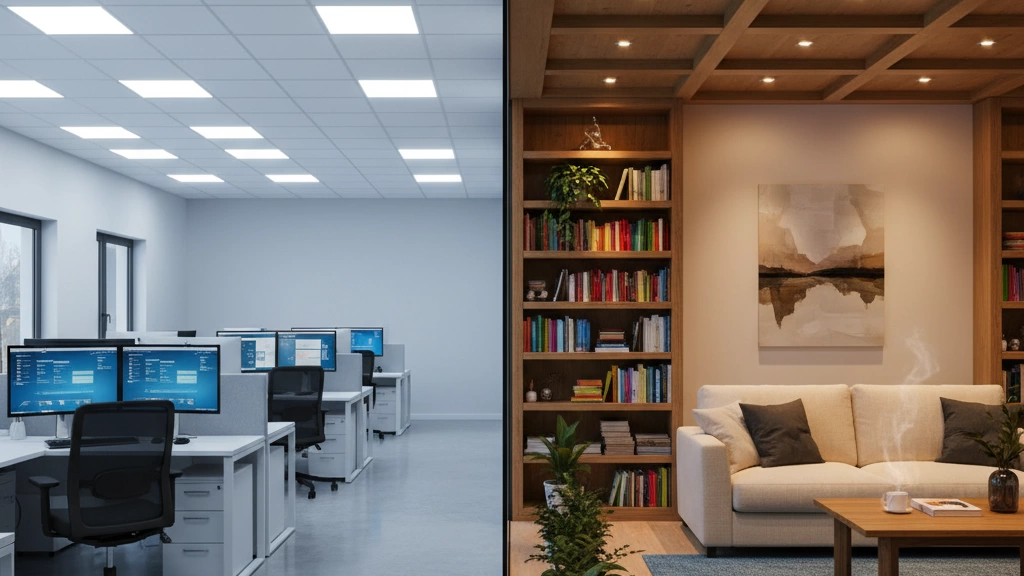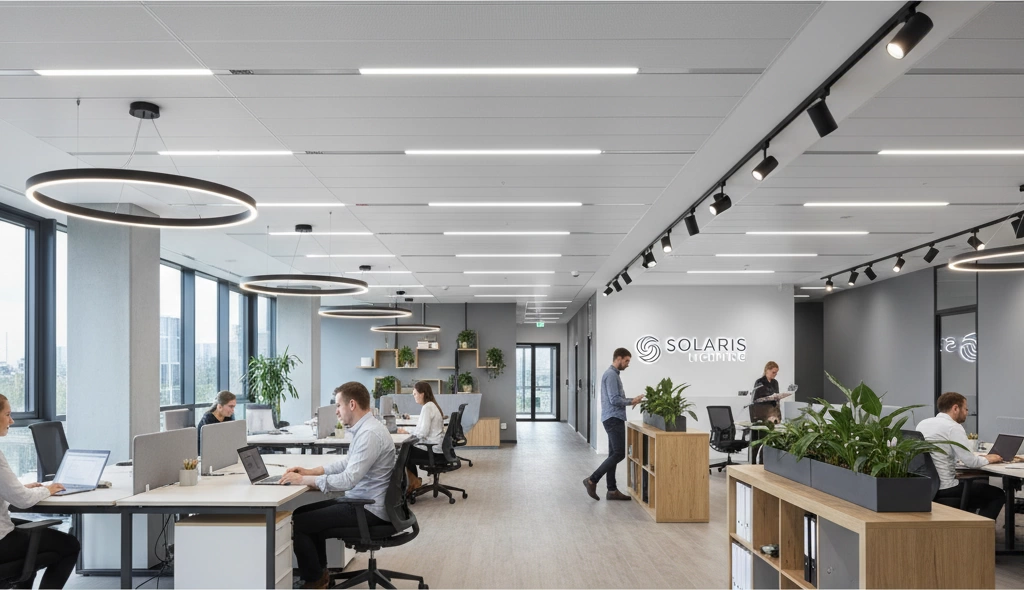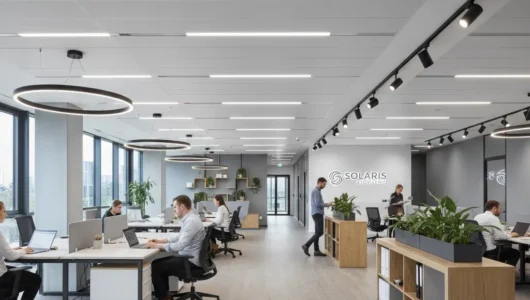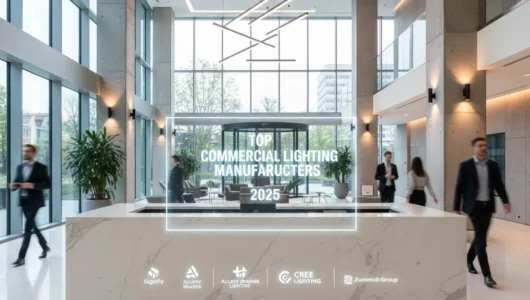If you’re managing a commercial space, you already know that lighting isn’t just about visibility—it’s one of your biggest energy expenses. Switching to kommersiell LED-belysning isn’t just a trend anymore; it’s a strategic move that can slash energy costs by up to 70%, drastically cut maintenance headaches, and boost your facility’s overall performance. In 2025, with rising utility rates and tighter energy codes, the question isn’t if you should upgrade—it’s when och how to do it right.
In this guide, we’ll break down everything you need to make smart decisions: from comparing commercial-grade LEDs versus cheaper options, to calculating real ROI, understanding rebates, and choosing the perfect fixtures for offices, warehouses, retail stores, and more. No fluff—just clear, actionable insights to help you get maximum value and long-term savings with kommersiell LED-belysning.
Let’s get started.
Key Benefits of Commercial LED Lighting vs Traditional Lighting
Switching to commercial LED lighting offers clear advantages over traditional lighting systems like metal halide, fluorescent, or incandescent fixtures. Here’s how LEDs stack up:
1. Energy Savings (50-80%)
- Commercial LEDs use 50-80% less energy than traditional lamps.
- This directly cuts electricity bills, especially in large facilities operating 10+ hours daily.
- Example: Replacing a 400W metal halide high bay with a 150W LED reduces energy use by 62.5%.
| Lighting Type | Typical Wattage | LED Equivalent | Energibesparingar |
|---|---|---|---|
| Metal Halide High Bay | 400W | 150W | 62.5% |
| Fluorescent Troffer | 80W | 30W | 62.5% |
2. Longer Lifespan & Maintenance Reduction
- LEDs last 50,000 to 150,000 hours, compared to 8,000–20,000 hours for traditional lights.
- Fewer replacements reduce labor and maintenance costs.
- Ideal for hard-to-reach commercial spaces like warehouses and parking structures.
3. Superior Light Quality
- Hög Color Rendering Index (CRI) of 80+ enhances visibility and reduces eye strain.
- Flexible color temperature options (3000K to 5000K) match different commercial needs:
- 3000K: Warm white for hospitality, retail
- 4000K: Neutral for offices, schools
- 5000K: Daylight for warehouses, manufacturing
4. Smart Controls & IoT Integration
- Compatible with occupancy sensors, daylight harvesting, and building automation.
- Enables:
- Dynamic dimming,
- Scheduling,
- Remote monitoring to optimize energy use.
- Supports future-ready smart building systems.
5. Environmental & ESG Compliance
- LEDs contribute to sustainability goals due to:
- Reduced energy consumption,
- Lower carbon emissions,
- Mercury-free, recyclable components.
- Meets many ESG reporting standards, helping companies comply with regulations and improve green credentials.
Table: Commercial LEDs vs Traditional Lighting
| Funktion | Commercial LEDs | Traditional Lighting |
|---|---|---|
| Energy Use | 50-80% less | Higher |
| Lifespan | 50,000–150,000 hours | 8,000–20,000 hours |
| Light Quality (CRI) | 80+ (adjustable color temp.) | 60–75 (fixed) |
| Controls & Automation | Full IoT & smart control ready | Limited or none |
| Environmental Impact | Low (no mercury, recyclable) | Higher (mercury, waste) |
Choosing commercial LED lighting leads to significant operational savings, improved lighting quality, and aligns with modern sustainable business practices.
Understanding Commercial-Grade vs Residential-Grade LEDs

Not all LEDs are built the same—especially when comparing commercial-grade to residential-grade lighting. Commercial LED lighting demands tougher build quality because these fixtures run longer hours, face harsher environments, and often are subject to strict energy codes.
Key Differences:
- Build Quality & Heat Management: Commercial LEDs use higher-quality materials and better heat sinks to keep temperatures low. This prevents early failure and maintains performance over time. Residential LEDs often cut corners here, which leads to overheating and flickering.
- Driver Quality: The driver—essentially the LED’s power supply—is made to last in commercial fixtures. They handle voltage fluctuations better and provide more stable light output. Cheap “commercial” LEDs usually pack lower-quality drivers that burn out quickly.
- Important Certifications: Look for DLC Premium listings, Title 24 compliance, and UL ratings for damp/wet locations. These certifications confirm that the fixture meets energy efficiency standards and can safely function in commercial spaces—even outdoors or in humid environments.
Why Cheap “Commercial” LEDs Fail Fast
Many budget LEDs sold as “commercial grade” actually lack these design elements and certifications. They may look similar but often:
- Don’t manage heat well, causing early LED or driver failure
- Lack proper electrical protections, risking outages
- Fail to meet local codes or qualify for rebates
- Result in higher maintenance and replacement costs
Choosing true commercial-grade LED lighting ensures durability, compliance, and cost savings in the long run—something every business should consider when upgrading lighting.
Most Popular Types of Commercial LED Fixtures in 2025
When it comes to commercial LED lighting in 2025, different fixtures fit different spaces. Here’s a quick look at the most popular types you’ll see in warehouses, offices, parking lots, and more:
High Bays & Low Bays
Ideal for warehouses, manufacturing plants, and large indoor spaces with high ceilings. High bay lights deliver bright, even illumination from 20 feet or more, while low bays suit areas with lower ceilings. These commercial LED high bay lights are energy-efficient and rugged, built to last in tough environments.
Troffer & Panel Lights
Common in offices, schools, and healthcare settings, LED troffer and panel lights fit standard ceiling grids. They offer smooth, glare-free light with adjustable color temperatures — perfect for maintaining productivity and comfort.
Linear Strip Lights & Vapor-Tight Fixtures
Linear strip lights are versatile for retail aisles and workstations, while vapor-tight LED fixtures are built for harsher locations like parking garages and food processing plants. Their sealed designs protect against dust, moisture, and chemicals.
Canopy & Wall Packs
Used mostly outdoors, LED canopy lights and wall packs brighten gas stations, building exteriors, and walkways. These fixtures improve security and visibility, with many options for DLC Premium LED fixtures that qualify for rebates.
Retrofit Kits vs Full Fixture Replacement
Retrofitting involves upgrading existing fixtures with LED kits, which can be cost-effective and faster to install. Full fixture replacement offers better performance and longer-term savings but comes with higher upfront costs. The choice depends on your building’s layout, budget, and future plans.
Each of these commercial light fixtures is designed to boost energy efficiency, reduce maintenance, and enhance the overall lighting quality in commercial spaces.
How to Choose the Right Commercial LED Lighting for Your Space
Picking the right commercial LED lighting can feel tricky, but breaking it down step-by-step makes it simple. Here’s how to get it right:
Step-by-step Selection Framework
-
Determine Your Lighting Goals
Energy savings, better light quality, compliance, or smart control?
Calculate Required Brightness (Lumens per Watt)
More lumens per watt means better energy efficiency.
For commercial spaces, aim for 100+ lm/W.Choose Beam Angle & Fixture Spacing
Narrow beam for focused lighting (e.g., high bays).
Wider beam for general lighting (e.g., offices, retail).
Space fixtures based on beam angles to avoid dark spots.Pick the Right Color Temperature
Tillämpning Recommended Color Temp (K) Use Case Examples Varm vit 2700–3500K Retail, hospitality for warm, comfortable feel Neutral White 3500–4500K General offices, schools, healthcare Kall vit 4500–6500K Warehouses, manufacturing, parking lots - Check IP & IK Ratings for Harsh Environments
- IP-klassning measures protection against dust/water.
- IP65+ needed for outdoors, parking garages, or wet areas.
- IK rating indicates impact resistance, important in industrial zones.
- IP-klassning measures protection against dust/water.
Quick Reference Table for IP & IK Ratings
| Area Type | Min IP Rating | Min IK Rating |
|---|---|---|
| Office/Indoor | IP20 | IK04 |
| Workshops | IP44 | IK07 |
| Parking Garages | IP65 | IK08 |
| Exterior/Gas Stations | IP65+ | IK10 |
Following this framework ensures you get commercial LED lighting that fits your space, complies with standards, and delivers the right brightness and durability.
Real ROI & Payback Calculation for Commercial LED Lighting
When it comes to commercial LED lighting, understanding your real return on investment (ROI) and payback period is crucial. Switching to energy-efficient commercial lighting can save you big over time, but you want clear numbers to back it up.
Simple Payback Formula
Here’s an easy way to estimate your payback period:
Payback Period = Total Upgrade Cost ÷ Annual Energy Savings
- Total Upgrade Cost includes fixtures, installation, and any controls.
- Annual Energy Savings comes from reduced electricity bills compared to your old lighting.
Using this formula, you can see how quickly your investment will pay for itself.
Free Calculator Tool
To make it even simpler, download our free Excel or Google Sheets calculator. Just enter your project details, and it will crunch the numbers for you—accounting for factors like energy rates, hours of use, and maintenance savings.
Utility Rebates & Programs in 2025 (US & Canada)
Many utilities across the US and Canada offer rebates to help lower upfront costs for commercial LED lighting upgrades. These incentives vary by region, fixture type, and efficiency level, but can shave hundreds or even thousands off your project.
- Look for DLC Premium LED fixtures rebates—they offer higher payouts.
- Check local utility sites or ask your supplier about 2025 rebate programs.
- Some programs require paperwork and pre-approval before installation, so plan ahead.
Financing & Tax Incentives
Besides rebates, several financing options and federal tax incentives make upgrading easier:
- Section 179D allows businesses to deduct a significant portion of the cost of energy-efficient lighting improvements on their taxes.
- Bonus depreciation can further reduce tax liability by allowing accelerated write-offs.
- Some states and municipalities offer additional credits or low-interest loans focused on commercial energy projects.
Bottom Line
By combining energy savings, rebates, and tax incentives, many businesses see payback periods well under 3 years. Use our calculator tool and explore available programs to ensure you maximize your ROI when upgrading your commercial LED lighting.
Lighting Controls & Smart Building Integration
Modern commercial LED lighting isn’t just about brightness—it’s about smart control. Systems like 0-10V, DALI, Zigbee, och Bluetooth mesh let you tailor lighting to your exact needs. These controls enable easy dimming, zoning, and scheduling that save energy and improve comfort.
Occupancy sensors automatically turn lights on or off when people enter or leave a room, cutting waste in low-use areas. Daylight harvesting adjusts artificial lighting based on natural light levels, which can shrink energy bills fast.
Looking ahead, integrating LED lighting with Power over Ethernet (PoE) and building management systems (BMS) is a game-changer. It provides centralized control, simpler maintenance, and valuable data to optimise your lighting and building performance for years to come.
Smart commercial lighting controls are your best bet for energy savings, convenience, and future-proofing your facility.
Installation Best Practices & Common Mistakes to Avoid

Getting your commercial LED lighting installed right is key to maximizing performance and savings. Here’s a simple checklist and tips to help avoid common headaches:
Contractor Checklist
- Verify that the contractor understands kommersiell LED-belysning specs and local codes.
- Confirm they’re familiar with both retrofitting existing fixtures and full new layout installations.
- Make sure they have experience with wiring commercial LEDs safely and efficiently.
- Check that they plan for proper heat dissipation to avoid early failures.
- Request glare control measures to ensure comfortable, high-quality light.
Retrofitting vs New Layouts
- Retrofitting saves money by upgrading your current fixtures with LED retrofit kits. It’s faster but may limit design flexibility.
- New fixture layouts offer better light distribution and future-proofing but require more upfront planning and cost.
- Evaluate the condition of your existing infrastructure to decide which approach works best.
Wiring & Heat Management Tips
- Use wiring rated for LED demands, considering voltage and environment.
- Ensure drivers have proper ventilation—LEDs produce less heat than traditional bulbs but still need airflow.
- Avoid bundling cables tightly; this reduces heat buildup and enhances safety.
Glare Reduction Tips
- Angle fixtures to reduce direct eye exposure.
- Use diffusers or lenses designed for commercial applications.
- Choose the right color temperature (usually 4000K to 5000K) to balance brightness with comfort.
Proper installation not only extends the lifespan of your commercial light fixtures but also boosts energy efficiency and occupant comfort. Avoid shortcuts here to get the most out of your investment.
Top Commercial LED Lighting Projects & Case Studies (2024–2025)

Let’s look at some real-world wins with commercial LED lighting to see what it can do:
- Warehouse Upgrade: Swapping out old fixtures for commercial LED high bay lights cut energy use by 72%. That’s a huge drop in electricity bills, plus less heat generation means a cooler workspace.
- Class-A Office Space: Installing office LED troffer lights improved employee satisfaction. The better light quality and adjustable color temperatures helped reduce eye strain and boosted overall mood and productivity.
- Big-Box Retail Store: Upgrading to commercial LED canopy lights and vapor tight fixtures made merchandise look sharper and more inviting. Plus, because LEDs give off less heat, the store saved on cooling costs during busy hours.
These cases show energy savings, better working conditions, and bottom-line improvements — powerful reasons to switch to commercial LED lighting today.
Sunmelighting – Your Trusted Commercial LED Partner

When it comes to commercial LED lighting, Sunmelighting stands out as a reliable partner for businesses worldwide. We hold key certifications like DLC Premium och ISO 9001, ensuring our products meet the highest standards for energy efficiency and quality. Plus, all our fixtures come with a 10-year warranty, giving you peace of mind on every installation.
Flagship Product Series
Our top product lines cover everything from commercial LED high bay lights for warehouses to office LED troffer lights och vapor tight LED fixtures for tough environments. Each series is backed by detailed spec tables showing lumen output, color temperature options, and energy savings—making it simple to pick the right fit.
Why Contractors & Specifiers Choose Us
- Trusted for long-lasting durability and robust build quality
- Consistent performance with DLC Premium LED fixtures for rebate eligibility
- Expert support on lighting layouts and energy optimization
- Competitive pricing without cutting corners
Free Lighting Layout & Audit Service
To help you get the best results, we offer a free lighting layout and audit. Our experts analyze your space to recommend the ideal fixtures, proper spacing, and controls so your commercial lighting system delivers maximum energy savings and compliance with local codes like Title 24.
Partnering with Sunmelighting means you’re investing in proven quality and tailored support that simplifies your commercial LED lighting projects from start to finish.
Frequently Asked Questions About Commercial LED Lighting
Are commercial LEDs dimmable?
Yes, most commercial LED fixtures are dimmable. However, you need to check the driver type and compatibility with your dimmer system—some require specific controls like 0-10V or DALI to work smoothly.
How long do commercial LED drivers really last?
Quality commercial LED drivers typically last between 50,000 to 100,000 hours. Better drivers mean fewer failures and lower maintenance costs. Cheap drivers can fail much sooner, leading to unexpected downtime.
What is DLC Premium and why does it matter for rebates?
DLC Premium is a certification showing the lighting product meets high energy-efficiency and performance standards. Products with DLC Premium status often qualify for better utility rebates, making your commercial lighting upgrade more affordable.
Can I use residential LEDs in a commercial space?
It’s not recommended. Commercial-grade LEDs are built tougher to handle higher use, better heat management, and specific safety ratings like Title 24 or UL for damp/wet locations. Residential LEDs might fail faster and risk non-compliance with codes.
How do I find local utility rebates?
Start by checking your city or state energy office website or your utility provider’s website. Many offer updated commercial lighting rebates for 2025. You can also ask your commercial LED lighting supplier—they often guide you through available incentives and help with paperwork.
Har du ingen e-postadress för ditt företag? Klicka här!
Innehållsförteckning
Har du ingen e-postadress för ditt företag? Klicka här!




